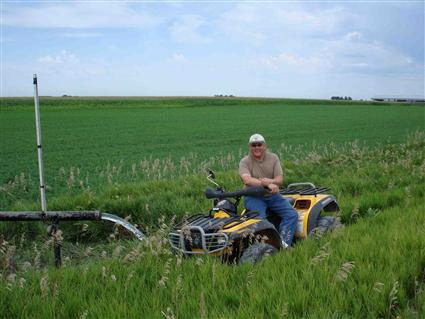Testimonials
Todd M.- Beaver Creek Golf Club
"You found a great spot for the well... we needed 300 gpm for the golf course but it looks like you found much more than that."
Todd is the owner of a 36-hole golf course. His existing water supply came from two wells that produced 50 and 220 gpm. A long dry period scourged the area and forced Todd to seek an additional water source. In order to sustain his pristine golf course, Todd needed an auxiliary well that could produce 300 gpm; otherwise, he would have to close nine holes just to save the rest of the course. A well drilling company was hired to drill the water well but the results were unsatisfactory. They drilled 80 feet from an existing well and the disheartening outcome was a dry hole. At that point Todd called Aquetech to help. We were able to locate another site; in two days the drilling company came back and started drilling again . This time they were successful. The water well was 96 feet deep and produced 360 gpm with only 16 feet of drawdown. Todd was thrilled and later told us that now he had so much water he had to shut down the well because his supply ponds were running over.
 George B.- Sherman Nursery
George B.- Sherman Nursery
"We had to stop drilling on your site because they were blowing so much water out of the well that we couldn't pump it away fast enough."
George is in charge of a nursery that ships its product all over the world. Since the nursery grows a vast number of acres of trees, shrubs and flowering plants, an extremely high volume of water is needed for irrigation. When George contacted Aquetech he wanted at least 1000 gpm for a new nursery site. We looked at the data and found that most of the water wells in that area are located in fractured limestone and can yield high volumes of water; but while the limestone formation is consistent, the fractured areas within the formation have extreme variability. These fractured areas require pinpoint accuracy to locate, and even then, finding an area that is highly fractured can present another challenge. Within a week after Aquetech was initially contacted, we located a drilling site that was close to an existing waterway. When the water well was installed, the driller used an air hammer when the limestone was encountered. Fractures in the lime rock were encountered within 200 feet of the surface. By 250 feet so much water was coming out of the well that it couldn't be pumped away fast enough and drilling had to stop. (The state law required that: no water from the drilling of a well could be allowed to flow directly into the waterway but had to be pumped away from the site). The driller reported that the fractured formation in that area usually didn't end until 280 feet and if they could have gone deeper, the chances of picking up significantly more water were very high. It was estimated that at least 3000 gpm was obtained. Who knows what the well would have produced if the driller had been able to drill another 30 feet to the bottom of the aquifer?
Jory- Bresnahan Well Drilling
"I have never seen anything like this before. We drilled less than 20 feet away from a dry hole and got enough water for his entire operation."
Jory was the second well driller working for Todd, a livestock producer who had just finished building his hog production unit right on schedule. The last thing left to do was drill the water well. Unfortunately, Todd built the unit on an area of his property that was very hard to find water. After two dry holes, his well driller left and told Todd that he couldn't find any water on the property. Todd called Aquetech and told us that he had livestock coming to his new facility in three weeks and he needed water desperately. We were able to find him a drilling location and he called Jory at the second drilling company immediately. Within a week, Todd had plenty of water for his entire operation. What is most amazing about this story is that the new water well was only 14 feet away from one of the dry holes.
Joe- Livestock Producer
"We are running everything off of the well that you have found and it's doing great. The four other wells just couldn't keep up."
Joe is a livestock producer who built a large hog facility and then struggled to get enough water for his livestock. He drilled and bored holes all over his property within a period of seven years and finally ended up with two shallow and two deep wells that were barely producing enough water. A dry summer came and both of his shallow wells were going dry. He hired a well driller to try and find water but after a couple of failed attempts the driller gave up. Joe contacted Aquetech and within a couple of days we found a location that was relatively close to his facility. After the well was completed, it produced five times more water than all of the other wells combined. When we followed up with Joe later, he told us he had shut off the other wells and was now using the well that Aquetech found to run his entire operation.
John- Livestock Producer
 John is a livestock producer who raises over 5000 hogs. When the hog facility was first built, a water well was drilled to a depth of 525 feet with an initial yield of 25 gpm. After twelve years of use the water production dwindled to just 12 gpm. When the hogs began fighting for a drink of water in the summer, John called us. He had cleaned the well in an attempt to try and recover the original output but this proved to be unsuccessful. John's only option now was to drill a new well. It was estimated that the well would need to be drilled to a depth of 700-800 feet, if placed by the existing well. However, when Aquetech checked the data for his area, we learned that aquifers of channeled sandstone were possible by 320 feet; but to encounter a porous channeled sandstone formation required a precise GPS drilling location due to the variability of the aquifer. After completing a MIPA site analysis, a drilling location was determined approximately 700 feet away from the existing water well. When the new well was finished, it produced 160 gpm, over ten times more water than the existing well, and was only 319 feet deep.
John is a livestock producer who raises over 5000 hogs. When the hog facility was first built, a water well was drilled to a depth of 525 feet with an initial yield of 25 gpm. After twelve years of use the water production dwindled to just 12 gpm. When the hogs began fighting for a drink of water in the summer, John called us. He had cleaned the well in an attempt to try and recover the original output but this proved to be unsuccessful. John's only option now was to drill a new well. It was estimated that the well would need to be drilled to a depth of 700-800 feet, if placed by the existing well. However, when Aquetech checked the data for his area, we learned that aquifers of channeled sandstone were possible by 320 feet; but to encounter a porous channeled sandstone formation required a precise GPS drilling location due to the variability of the aquifer. After completing a MIPA site analysis, a drilling location was determined approximately 700 feet away from the existing water well. When the new well was finished, it produced 160 gpm, over ten times more water than the existing well, and was only 319 feet deep.
Jack D., City of Lake View
Jack maintains the water wells and the water distribution system for the city of Lake View. The city's wells were slowing in production and they needed an additional 300 gpm. Jack called a drilling company and attempted a test well that resulted in an output of only 20 gpm. In the Lake View area, there are channeled sand and gravel deposits that vary greatly in production and consistency. After Jack contacted Aquetech, we located a site that was approximately three blocks from the site of the test well. The new well was drilled to a depth of 120 feet with a yield of 700 gpm.
Pat T.- McClure Engineering
Pat is an engineer whose specialty is water distribution. He was working with the city of Story City to try and find a site for an additional water well. This water well would supplement the two existing wells that were gradually slowing in production. Aquifers in this area are found in fractured limestone and placement for the well must be accurate to encounter as many fractures as possible. Pat contacted Aquetech to locate a site for the well. When the water well was finsihed, it had to be capped because so much water was flowing over the top. When the well was pumped it yielded 700 gpm.